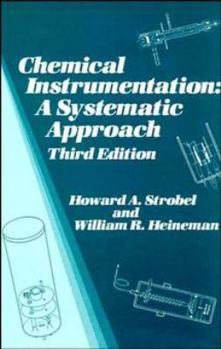Chemical Instrumentation: A Systematic Approach
The Third Edition of this established work on chemical instrumentation has been completely rewritten and updated to account for the advances made since the Second Edition came out in 1973. More main... This description may be from another edition of this product.
Format:Hardcover
Language:English
ISBN:0471612235
ISBN13:9780471612230
Release Date:February 1989
Publisher:Wiley-Interscience
Length:1248 Pages
Weight:3.80 lbs.
Dimensions:2.0" x 6.7" x 9.6"
Customer Reviews
1 rating
an advanced level survey of analytical instrumentation
Published by Thriftbooks.com User , 16 years ago
This is one of my favorite books on Instrumental Analysis. It's basically a combination of 3/4 reference material and 1/4 teaching material on analytical chemical instrumentation. It's designed for undergraduates in senior analytical chemistry courses and grad students. Could also be used by working (analytical) chemists as a refresher or to learn new techniques. Its best feature is the broad and deep coverage of the big 3 analytical techniques - chromatography, spectroscopy and electrochemistry. Although, too many chapters are devoted to electrochemistry. This subject is of interest to academics but the problem is in the real world of analytical chemistry the 2 major workhorses are spectroscopy and separations. Electrochemical techniques are just not that widely used & certainly not to the extent you'd think after reading this book. Besides the big 3, we get everything else a student is likely to encounter: electronics, computers & data acquisition, optics, stats, measurement theory, S/N basics, mass spec., X-ray fluorescence, surface techniques and radioisotopes. Some of these topics are not treated with the depth they deserve. To do this they'd need a 2nd volume (actually, not a bad idea, come to think of it) The book is VERY hardware oriented. It's more advanced than either Skoog's book (Principles of Instrumental Analysis) or Willard's text (Instrumental Methods of Analysis). This book works best as a supplement to the above 2 texts for students wanting deeper or alternative explanations of selected topics. Reading this book will prepare anyone for advanced material like Spectrochemical Analysis by Ingle & Crouch or Bard & Faulkner's Electrochemical Methods. Book has lots of excellent diagrams and tables to explain the subject at hand. End of chapter references also very good - they contain student-relevant articles and books for those looking for even further edification. Previous editions did not have the extra expository material found in the examples or end-of-chapter problems. However, the problems are often simple and don't really add much value to the book. They seem like they were added as an afterthought to try and make 3rd edition into a full textbook. It didn't work. only other negative point: since this book tries to survey the whole field of chemical instrumentation it becomes very thick: 1200+ pages. As such, there's not enough space to derive the equations from first principles. The equations are simply presented. If you want all the gory details you'll have to look elsewhere. like an optics textbook for instance.





